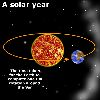The year that we are most familiar with has 365 days, divided into 12 months or just over 52 weeks. The problem with this definition of a year is that it is based on three different time units, derived from different astronomical movements.
A day is the time for one rotation of the Earth on its axis. A week is approximately a quarter of a lunar month. A month is approximately one orbit of the Moon around the Earth, while a year is the time taken for the Earth to orbit the Sun.
 The movements of the Earth, Moon and Sun are not astronomically connected
and thus years, months, weeks and days do not relate to each other in
whole number quantities as the first indications might suggest.
The movements of the Earth, Moon and Sun are not astronomically connected
and thus years, months, weeks and days do not relate to each other in
whole number quantities as the first indications might suggest.
The year
The term "year" is generally understood to be the time required
for the Earth to travel once around the Sun, which is about 365 1/4 days.
There are different definitions of a year (see below), but the most commonly
accepted one is called the Tropical Year. Its length is 365 days 5 hours
48 minutes 46 seconds, and is defined as the time between two vernal equinoxes,
when the Sun, as seen from Earth, appears to cross the equator moving
north.

|
Sun over the equator |
Leap years
The extra quarter day in the solar year requires a periodic adjustment
of the calendar to keep it in touch with the seasons. Julius Caesar was
the first person to introduce the idea of a leap year. His leap year rule
added a day to February every four years. Our current calendar, the Gregorian
calendar, only differs from the Julian calendar in that the leap year
rule was changed. Every fourth year is a leap year except for centuries,
which are only a leap year if they are divisible by 400.
Let's look at the last 400 years. 1700 was not a leap year, but 1704, 1708 through to 1796 were leap year, 1800 was not made a leap year again and so this pattern continued until the year 2000, which became a leap year because it is divisible by 400. Over 400 years, this evens things up a bit, but the calendar is still about 2.8 hours ahead of the seasons.
Although not specifically part of the Gregorian calendar, it has been suggested that the 2.8 hours per 400 years be compensated for by declaring each year divisible by 4 000 a normal year and not a leap year, the next being the year 4 000! What about the 4 hours we are still short of each 4 000 years, I hear you say? I wonder if we will still be using the Gregorian calendar in 2000 years time?
Some other years
Two other more technical measurements of the year are the Sidreal Year
and the Anomalistic Year. The Sidereal Year of 365 days 6 hours 9 minutes
10 seconds, is a measure of the Earth's orbit against the stars. The Anomalistic
Year of 365 days 6 hours 13 minutes 53 seconds, is the time taken by the
Earth to pass around one orbit of the Sun from one perihelion, the point
in its orbit nearest the Sun, to the next.
Another motion involving the Earth, is the Solar System revolving around the centre of our Milky Way Galaxy, completing a revolution about every 225 million years. This year is called the Cosmic Year.
| Copyright owned by the State of Victoria (Department of Education and Early Childhood Development). Used with Permission. |
|
|||||||||||||||||||||||||||||||||||||||||||||||||||||||||||||||||||||||||||||||||||||